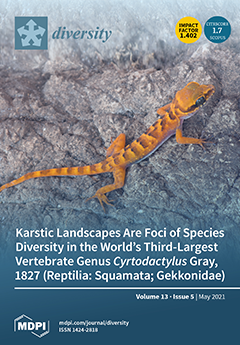Heretofore, the populations of the genus
Sphaerotheca Günther, 1859 (Dicroglossidae) in their northern and western borders laying in Pakistan have been assigned to two species,
S. breviceps (Schneider, 1799) and
S. strachani (Murray, 1884). The genus originated in the Oriental zoogeographic region and
[...] Read more.
Heretofore, the populations of the genus
Sphaerotheca Günther, 1859 (Dicroglossidae) in their northern and western borders laying in Pakistan have been assigned to two species,
S. breviceps (Schneider, 1799) and
S. strachani (Murray, 1884). The genus originated in the Oriental zoogeographic region and comes to close geographic proximity with the Palearctic region in Pakistan. The recent molecular studies have on one hand restricted the distribution range of
S. breviceps to the eastern coastal plains of India and, on the other hand, revealed the northern- and westernmost population in India as a separate species,
S. pashchima Padhye et al., 2017. This species has recently been synonymized with
S.
maskeyi (Schleich and Anders, 1998). These taxonomic changes, however, warranted the need for validation of Pakistani
Sphaerotheca based on genetic data. We sequenced and analyzed 16S rRNA mitochondrial gene from specimens originating from the Himalayan foothills of Pakistan and compared these with all available GenBank sequences of the genus. Based on this data, we conclude that the Himalayan foothills of Pakistan are occupied by
S. maskeyi. Simultaneously, we bring the first record of this species for the Palearctic region. We further suggest that more genetic material from across Pakistan is required to ascertain the validity of
S. strachani and for the phylogeographic evaluation of western and northern border populations of the genus. Our geographically wide and revisited molecular phylogeny shows that the genus exhibits genetic diversity suggesting further taxonomic changes. The low level of genetic divergences between
S.
breviceps and
S.
magadha Prasad et al., 2019 compared to other species of the genus, indicates that the taxonomic status of
S.
magadha is questionable. Moreover, we found that
S.
magadha and
S.
swani (Mayers and Leviton, 1956) are genetically conspecific with
S.
breviceps and both should be thus considered its junior synonyms. On the other hand,
S.
dobsonii and populations from Myanmar need further detailed investigations.
Full article





